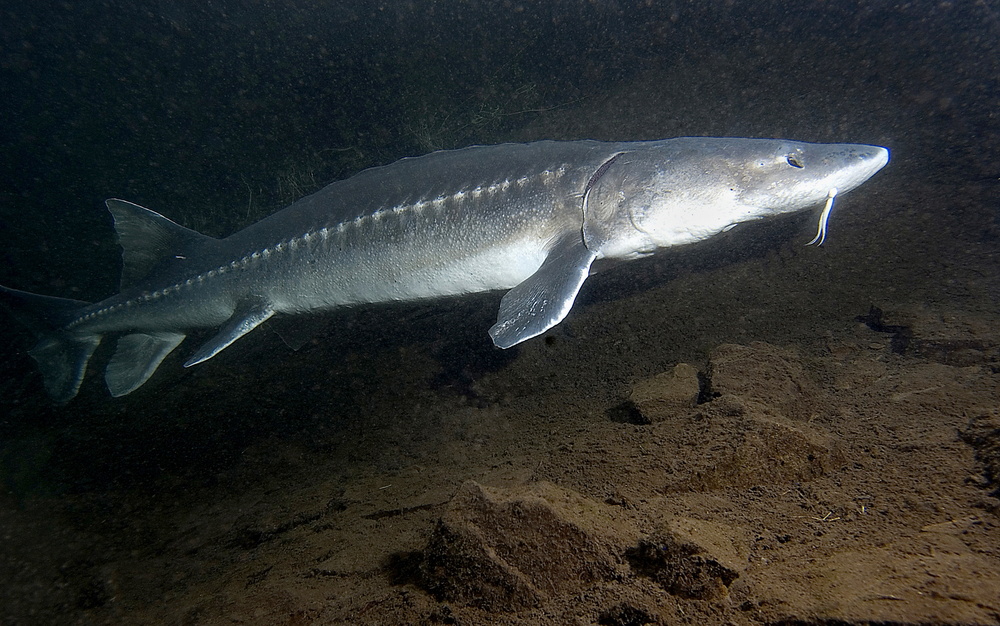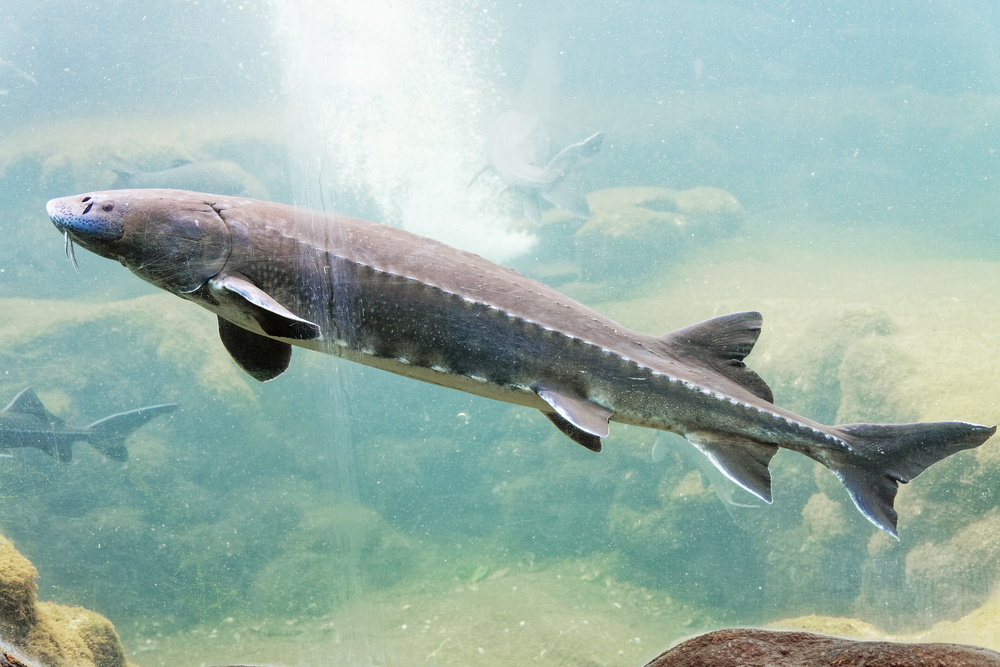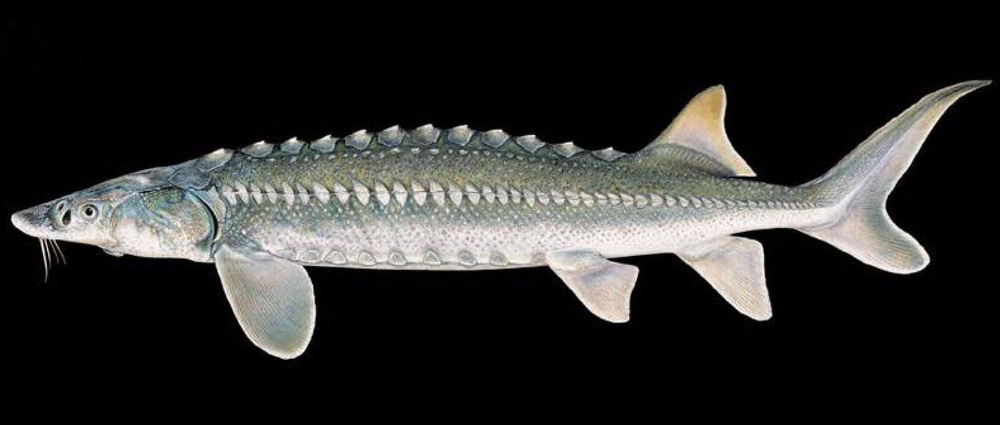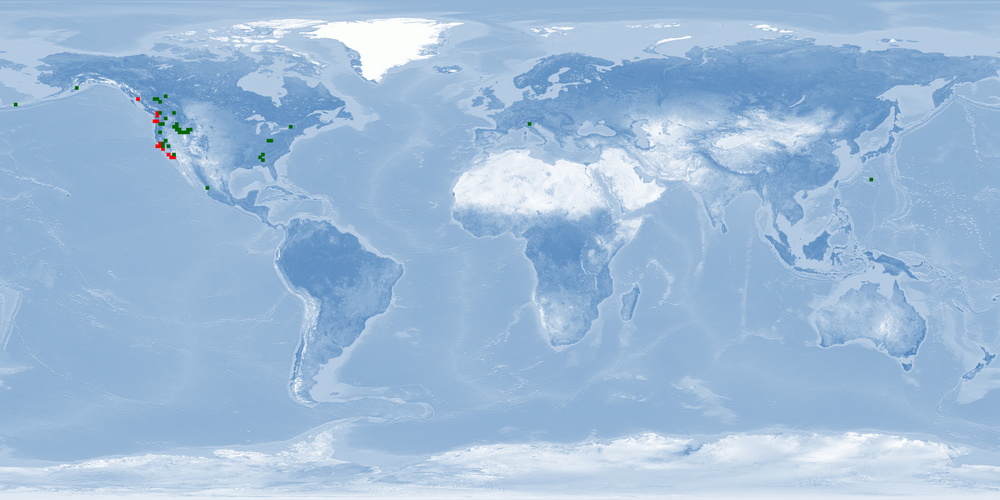Information
Version: B | 1.1 (2022-01-22)
Please note: This part of the profile is currently being revised.
WelfareScore | farm
Condensed assessment of the species' likelihood and potential for good fish welfare in aquaculture, based on ethological findings for 10 crucial criteria.
- Li = Likelihood that the individuals of the species experience good welfare under minimal farming conditions
- Po = Potential of the individuals of the species to experience good welfare under high-standard farming conditions
- Ce = Certainty of our findings in Likelihood and Potential
WelfareScore = Sum of criteria scoring "High" (max. 10)
General remarks
Acipenser transmontanus is a long-lived and late-maturing species found on the Pacific coast of North America. It is the largest freshwater fish in its distribution range. Although mostly anadromous, there are some non-migrating populations. Once very abundant, it was overfished almost until extinction in the early 20th century, and only through severe fishing restrictions that are still applied its populations were allowed to recover. Farming started in the late 20th century, and although there is a fair amount of research on this species, there are still considerable knowledge gaps and sub-optimal practices that influence its welfare in farming. Namely, behaviour in the wild lacks studies, spatial needs are not met, reproduction is highly manipulated and invasive, substrate requirements are mostly absent, and an effective protocol for stunning and slaughtering is not established. Further effort to provide a more natural environment in farming conditions, natural spawning, and humane stunning and slaughtering should result in improved welfare.
1 Home range
Many species traverse in a limited horizontal space (even if just for a certain period of time per year); the home range may be described as a species' understanding of its environment (i.e., its cognitive map) for the most important resources it needs access to.
What is the probability of providing the species' whole home range in captivity?
It is low for minimal and high-standard farming conditions. Our conclusion is based on a high amount of evidence.


2 Depth range
Given the availability of resources (food, shelter) or the need to avoid predators, species spend their time within a certain depth range.
What is the probability of providing the species' whole depth range in captivity?
It is low for minimal farming conditions. It is medium for high-standard farming conditions. Our conclusion is based on a medium amount of evidence.


3 Migration
Some species undergo seasonal changes of environments for different purposes (feeding, spawning, etc.), and to move there, they migrate for more or less extensive distances.
What is the probability of providing farming conditions that are compatible with the migrating or habitat-changing behaviour of the species?
It is low for minimal farming conditions. It is medium for high-standard farming conditions. Our conclusion is based on a medium amount of evidence.


4 Reproduction
A species reproduces at a certain age, season, and sex ratio and possibly involving courtship rituals.
What is the probability of the species reproducing naturally in captivity without manipulation of theses circumstances?
It is low for minimal and high-standard farming conditions. Our conclusion is based on a medium amount of evidence.


5 Aggregation
Species differ in the way they co-exist with conspecifics or other species from being solitary to aggregating unstructured, casually roaming in shoals or closely coordinating in schools of varying densities.
What is the probability of providing farming conditions that are compatible with the aggregation behaviour of the species?
It is unclear for minimal farming conditions. It is medium for high-standard farming conditions. Our conclusion is based on a low amount of evidence.


6 Aggression
There is a range of adverse reactions in species, spanning from being relatively indifferent towards others to defending valuable resources (e.g., food, territory, mates) to actively attacking opponents.
What is the probability of the species being non-aggressive and non-territorial in captivity?
It is unclear for minimal farming conditions. It is medium for high-standard farming conditions. Our conclusion is based on a medium amount of evidence.


7 Substrate
Depending on where in the water column the species lives, it differs in interacting with or relying on various substrates for feeding or covering purposes (e.g., plants, rocks and stones, sand and mud, turbidity).
What is the probability of providing the species' substrate and shelter needs in captivity?
It is low for minimal farming conditions. It is high for high-standard farming conditions. Our conclusion is based on a medium amount of evidence.


8 Stress
Farming involves subjecting the species to diverse procedures (e.g., handling, air exposure, short-term confinement, short-term crowding, transport), sudden parameter changes or repeated disturbances (e.g., husbandry, size-grading).
What is the probability of the species not being stressed?
It is low for minimal farming conditions. It is medium for high-standard farming conditions. Our conclusion is based on a high amount of evidence.


9 Malformations
Deformities that – in contrast to diseases – are commonly irreversible may indicate sub-optimal rearing conditions (e.g., mechanical stress during hatching and rearing, environmental factors unless mentioned in crit. 3, aquatic pollutants, nutritional deficiencies) or a general incompatibility of the species with being farmed.
What is the probability of the species being malformed rarely?
It is unclear for minimal and high-standard farming conditions. Our conclusion is based on a low amount of evidence.


10 Slaughter
The cornerstone for a humane treatment is that slaughter a) immediately follows stunning (i.e., while the individual is unconscious), b) happens according to a clear and reproducible set of instructions verified under farming conditions, and c) avoids pain, suffering, and distress.
What is the probability of the species being slaughtered according to a humane slaughter protocol?
It is low for minimal farming conditions. It is high for high-standard farming conditions. Our conclusion is based on a low amount of evidence.


Side note: Domestication
Teletchea and Fontaine introduced 5 domestication levels illustrating how far species are from having their life cycle closed in captivity without wild input, how long they have been reared in captivity, and whether breeding programmes are in place.
What is the species’ domestication level?
DOMESTICATION LEVEL 4 33, level 5 being fully domesticated.
Side note: Forage fish in the feed
450-1,000 milliard wild-caught fishes end up being processed into fish meal and fish oil each year which contributes to overfishing and represents enormous suffering. There is a broad range of feeding types within species reared in captivity.
To what degree may fish meal and fish oil based on forage fish be replaced by non-forage fishery components (e.g., poultry blood meal) or sustainable sources (e.g., soybean cake)?
All age classes: WILD: omnivorous 34, but mostly carnivorous 35. FARM: fish meal may be partly* replaced, and fish oil may be completely* replaced by non-forage fishery components 36.
*partly = <51% – mostly = 51-99% – completely = 100%
Glossary
ANADROMOUS = migrating from the sea into fresh water to spawn
DOMESTICATION LEVEL 4 = entire life cycle closed in captivity without wild inputs 33
FARM = setting in farming environment or under conditions simulating farming environment in terms of size of facility or number of individuals
IND = individuals
JUVENILES = fully developed but immature individuals, for details ➝ Findings 10.1 Ontogenetic development
LAB = setting in laboratory environment
LARVAE = hatching to mouth opening, for details ➝ Findings 10.1 Ontogenetic development
PHOTOPERIOD = duration of daylight
SPAWNERS = adults during the spawning season; in farms: adults that are kept as broodstock
WILD = setting in the wild
Bibliography
2 Conte, Fred Sequin, and University of California (System) Cooperative Extension. 1988. Hatchery Manual for the White Sturgeon (Acipenser Transmontanus Richardson): With Application to Other North American Acipenseridae. UCANR Publications.
3 Chebanov, Mikhail S., and Elena V. Galich. 2011. Sturgeon hatchery manual. FAO Fisheries and Aquaculture Technical Paper 558. Ankara: Food and Agriculture Organization of the United Nations.
4 Kynard, Boyd, and Erika Parker. 2005. Ontogenetic Behavior and Dispersal of Sacramento River White Sturgeon, Acipenser Transmontanus, with a Note on Body Color. Environmental Biology of Fishes 74: 19–30. https://doi.org/10.1007/s10641-005-2198-4.
5 Haynes, James M., Robert H. Gray, and Jerry C. Montgomery. 1978. Seasonal Movements of White Sturgeon (Acipenser transmontanus) in the Mid-Columbia River. Transactions of the American Fisheries Society 107: 275–280. https://doi.org/10.1577/1548-8659(1978)107<275:SMOWSA>2.0.CO;2.
6 Parsley, Michael J., Nicholas D. Popoff, Corey D. Wright, and Bjorn K. van der Leeuw. 2008. Seasonal and Diel Movements of White Sturgeon in the Lower Columbia River. Transactions of the American Fisheries Society 137: 1007–1017. https://doi.org/10.1577/T07-027.1.
7 Georgiadis, M. P, R. P Hedrick, W. O Johnson, and I. A Gardner. 2000. Mortality and recovery of runt white sturgeon (Acipenser transmontanus) in a commercial farm in California, USA. Preventive Veterinary Medicine 43: 269–281. https://doi.org/10.1016/S0167-5877(99)00105-1.
8 McLean, Montana F., Kyle C. Hanson, Steven J. Cooke, Scott G. Hinch, David A. Patterson, Taylor L. Nettles, Matt K. Litvak, and Glenn T. Crossin. 2016. Physiological stress response, reflex impairment and delayed mortality of white sturgeon Acipenser transmontanus exposed to simulated fisheries stressors. Conservation Physiology 4. https://doi.org/10.1093/conphys/cow031.
9 Galbreath, James L. 1985. Status, life history, and management of Columbia River white sturgeon, Acipenser transmontanus. Environmental Biology of Fishes 14.
10 Welch, DW, S Turo, and SD Batten. 2006. Large-scale marine and freshwater movements of white sturgeon. Transactions of the American Fisheries Society 135: 386–389.
11 McCabe, George, and Charles Tracy. 1994. Spawning and early life history of white sturgeon, Acipenser transmontanus, in the lower Columbia River. Fishery Bulletin 92: 760–772.
12 Morrow, James E. 1976. Freshwater fishes of Alaska. Fairbanks, Alaska: University of Alaska.
13 North, John A, Thomas A Rien, and Raymond C Beamesderfer. 1993. Distribution and movements of white sturgeon in three lower Columbia River reservoirs. Northwest Science 67.
14 Parsley, Michael J., Lance G. Beckman, and George T. McCabe Jr. 1993. Spawning and Rearing Habitat Use by White Sturgeons in the Columbia River Downstream from McNary Dam. Transactions of the American Fisheries Society 122: 217–227. https://doi.org/10.1577/1548-8659(1993)122<0217:SARHUB>2.3.CO;2.
15 Parsley, Michael J., and Lance G. Beckman. 1994. White sturgeon spawning and rearing habitat in the lower Columbia River. North American Journal of Fisheries Management 14: 812–827. https://doi.org/10.1577/1548-8675(1994)014<0812:WSSARH>2.3.CO;2.
16 Bajkov, Alexander. 1951. Migration of white sturgeon (Acipenser transmontanus) in the Columbia River. Oregon Fish Commission Research Briefs 3.
17 Geist, David R., Richard S. Brown, Valerie Cullinan, Steve R. Brink, Ken Lepla, Phil Bates, and James A. Chandler. 2005. Movement, Swimming Speed, and Oxygen Consumption of Juvenile White Sturgeon in Response to Changing Flow, Water Temperature, and Light Level in the Snake River, Idaho. Transactions of the American Fisheries Society 134: 803–816. https://doi.org/10.1577/T04-108.1.
18 Beamesderfer, Raymond C., and Anthony A. Nigro. 1992. Status and habitat requirements of the white sturgeon populations in the Columbia river downstream from McNary dam. 86–50. Portland, Oregon: U.S. Department of Energy, Bonneville Power Administration, Division of Fish and Wildlife.
19 Paragamian, Vaughn L., Virginia D. Wakkinen, and G. Kruse. 2002. Spawning locations and movement of Kootenai River white sturgeon. Journal of Applied Ichthyology 18: 608–616. https://doi.org/10.1046/j.1439-0426.2002.00397.x.
20 Saraiva, João L. 2018. Personal communication.
21 Doroshov, Serge I., Gary P. Moberg, and Joel P. Van Eenennaam. 1997. Observations on the reproductive cycle of cultures white sturgeon, Acipenser transmontanus. Environmental Biology of Fishes 48: 265–278. https://doi.org/10.1023/A:1007336802423.
22 Hatin, D., R. Fortin, and F. Caron. 2002. Movements and aggregation areas of adult Atlantic sturgeon (Acipenser oxyrinchus) in the St Lawrence River estuary, Quebec, Canada. Journal of Applied Ichthyology 18: 586–594. https://doi.org/10.1046/j.1439-0426.2002.00395.x.
23 Rosenthal, Harald, and Jörn Geßner. 1993. Activity patterns in cultured juvenile white sturgeon. Council Meeting C.M. 1993/F:12. ICES.
24 Parsley, M. J., C. D. Wright, B. K. Van Der Leeuw, E. E. Kofoot, C. A. Peery, and M. L. Moser. 2007. White sturgeon (Acipenser transmontanus) passage at the Dalles Dam, Columbia River, USA. Journal of Applied Ichthyology 23: 627–635. https://doi.org/10.1111/j.1439-0426.2007.00869.x.
25 Szczepkowski, Mirosław, Bożena Szczepkowska, and Iwona Piotrowska. 2011. Impact of higher stocking density of juvenile Atlantic sturgeon, Acipenser oxyrinchus Mitchill, on fish growth, oxygen consumption, and ammonia excretion. Archives of Polish Fisheries 19: 59–67. https://doi.org/10.2478/v10086-011-0007-6.
26 Deng, Dong-Fang, Shunsuke Koshio, Saichiro Yokoyama, Sungchul C Bai, Qingjun Shao, Yibo Cui, and Silas S. O Hung. 2003. Effects of feeding rate on growth performance of white sturgeon (Acipenser transmontanus) larvae. Aquaculture 217: 589–598. https://doi.org/10.1016/S0044-8486(02)00461-1.
27 Bennett, W. R., G. Edmondson, K. Williamson, and J. Gelley. 2007. An investigation of the substrate preference of white sturgeon (Acipenser transmontanus) eleutheroembryos. Journal of Applied Ichthyology 23: 539–542. https://doi.org/10.1111/j.1439-0426.2007.01003.x.
28 Simontacchi, Claudia, E. Negrato, M. Pazzaglia, D. Bertotto, C. Poltronieri, and G. Radaelli. 2009. Whole-body concentrations of cortisol and sex steroids in white sturgeon (Acipenser transmontanus, Richardson 1836) during early development and stress response. Aquaculture International 17: 7–14. https://doi.org/10.1007/s10499-008-9174-x.
29 Belanger, J. M, J. H Son, K. D Laugero, G. P Moberg, S. I Doroshov, S. E Lankford, and J. J Cech. 2001. Effects of short-term management stress and ACTH injections on plasma cortisol levels in cultured white sturgeon, Acipenser transmontanus. Aquaculture 203: 165–176. https://doi.org/10.1016/S0044-8486(01)00620-2.
30 Faulkner, Iwalani N., and Gary P. Moberg. 1997. Effects of short term management stress on the ability of GnRHa to induce gonadotropin secretion in male white sturgeon, Acipenser transmontanus. Aquaculture 159: 159–168. https://doi.org/10.1016/S0044-8486(97)00212-3.
31 Wang, Y. L., R. K. Buodington, and S. I. Doroshov. 1987. Influence of temperature on yolk utilization by the white sturgeon, Acipenser transmontanus. Journal of Fish Biology 30: 263–271. https://doi.org/10.1111/j.1095-8649.1987.tb05751.x.
32 Anonymous farmers. 2018. Personal communication.
33 Teletchea, Fabrice, and Pascal Fontaine. 2012. Levels of domestication in fish: implications for the sustainable future of aquaculture. Fish and Fisheries 15: 181–195. https://doi.org/10.1111/faf.12006.
34 Semakula, S. N., and P. A. Larkin. 1968. Age, Growth, Food, and Yield of the White Sturgeon (Acipenser transmontanus) of the Fraser River, British Columbia. Journal of the Fisheries Research Board of Canada 25: 2589–2602. https://doi.org/10.1139/f68-229.
35 Sprague, Calvin R, Lance G Beckman, and Stephen D Duke. 1993. Prey selection by juvenile white sturgeon in reservoirs of the Columbia River. Status and habitat requirements of the white sturgeon populations in the Columbia River downstream from McNary Dam 2: 229–243.
36 Palmegiano, Giovanni Battista, Francesco Gai, Franco Daprà, Laura Gasco, Mario Pazzaglia, and Pier Giorgio Peiretti. 2008. Effects of Spirulina and plant oil on the growth and lipid traits of white sturgeon (Acipenser transmontanus) fingerlings. Aquaculture Research 39: 587–595. https://doi.org/10.1111/j.1365-2109.2008.01914.x.

















